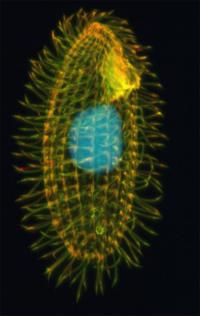
The genome sequence of the single-celled ciliate Tetrahymena thermophila sheds light on early eukaryotic evolution.In an effort to improve our understanding of eukaryotic evolution, a team of over 50 researchers led by Jonathan Eisen sequenced the macronuclear genome of the single-celled ciliate Tetrahymena themophila. Published online this week in the open-access journal PLoS Biology, the authors provide insights into the biology of this organism.
T. thermophila is particularly unusual inside. Each cell contains two nuclei: a micronucleus comprising only five chromosomes, and a macronucleus, which has more than 200. The micronucleus contains the DNA necessary for reproduction. The macronucleus controls the cell's other functions. When the cells mate, the micronucleus splinters into fragments, which in turn replicate to form many smaller chromosomes that become the macronucleus.
The researchers carried out shotgun sequencing on purified macronuclei DNA and then reconstructed the genome using computational techniques. They captured an estimated 95% of the genome and conclude it is 105 million base pairs in length and between 185 and 287 total chromosomes. The chromosomes lack centromeres (presumably as they do not undergo meiosis or mitosis), and have only a very small amount of repetitive DNA (much of it is excised from the micronucleus during macronucleus formation). The genome encodes over 27,000 protein-coding genes with some gene families having undergone expansion as exemplified by the more than 300 voltage-gated ion channels that control membrane transport--a critical function for this single-celled organism.
T. thermophila is known to only employ one stop codon (UGA) during protein synthesis; the two unused ones code for glutamine. As UGA can also code for selenocysteine, this is the only organism known so far to translate all 64 codons.
The sequenced genome permitted the authors to investigate plastid acquisition in the alveolates--a group of three related phyla, ciliates, apicomplexans (parasites including malaria causing Plasmodium), and dinoflagellates (oceanic photosynthetic protozoans). Plastids like chloroplasts are organelles descended from free-living cyanobacteria. Many of the genes are typically incorporated into the host nucleus. No evidence of plastids was found in T. thermophila, although they are present in both apicomplexans and dinoflagellates, indicating that plastid acquisition most likely occurred after they had split from the ciliates.
As a basal eukaryote, this genome will enable studies on eukaryotic evolution. The authors aim to next sequence the micronuclear genome. Source : Public Library of Science
 Print Article
Print Article Mail to a Friend
Mail to a Friend
